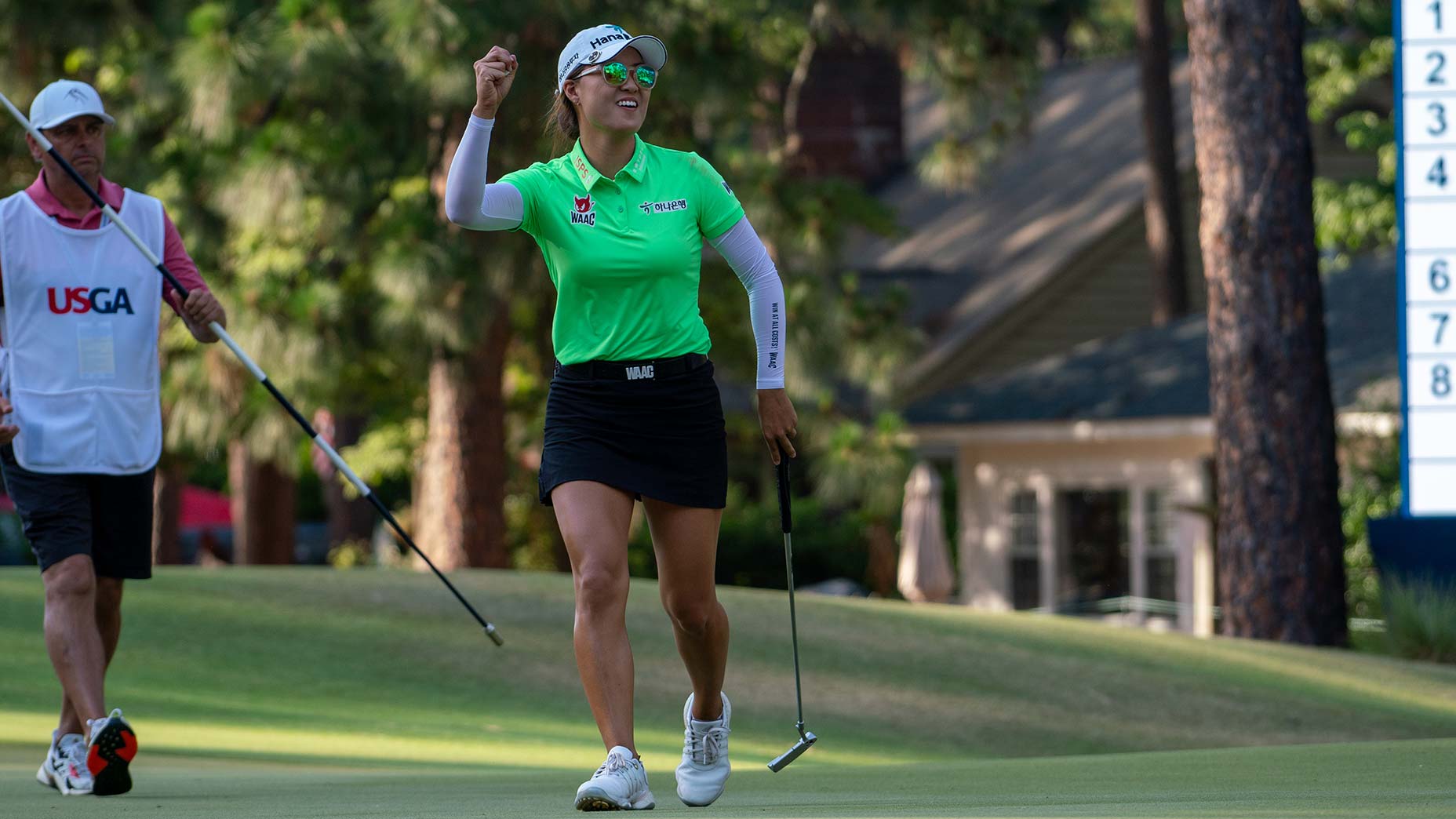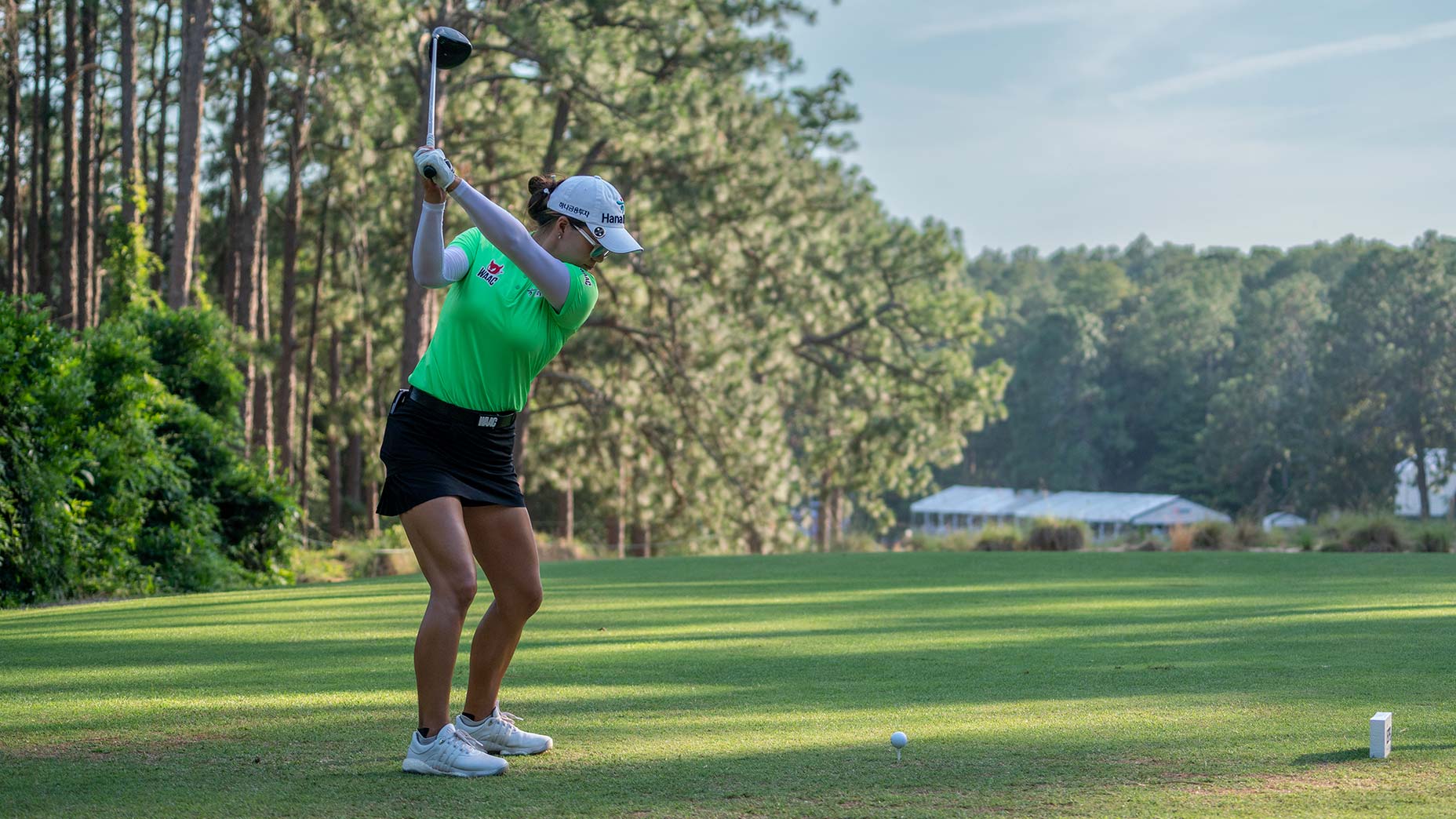
Minjee Lee’s championship Sunday didn’t come easily at the U.S. Women’s Open.
Darrien Riehl
SOUTHERN PINES, N.C. — It’s a long walk from inside the ropes to the first tee at Pine Needles, and even longer on Sunday.
The tee markers are way back on Sunday afternoon, further back than they’ve been all week, and that’s bad news for a few reasons. First, it means the monstrous par-5 first hole will play an extra 10 yards longer on Sunday. But it also means the tee shot, which already feels claustrophobic in its cubby corner between the 18th grandstand and first fairway, is about to get a whole lot more uncomfortable.
And then there’s the matter of the trophy. The groups first appear from a small gap in the ropes roughly 40 yards into the fairway before turning back toward the tee box. In an ingenious piece of skullduggery, the USGA has elected to place the Harton S. Semple trophy in the center of the tee box, directly within view of every player who walks down the path.

The first tee box at Pine Needles was ripe for pressure on Sunday morning.
Darren Riehl
Most of those in the final groups try to downplay the moment as they walk to the first tee, keeping their eyes low and their expressions serious. It’s clear, however, that things are not as they appear.
First come Bronte Law and Lydia Ko, the penultimate group. They’re anxious to get going — starting the day six and seven strokes back, respectively — and it’s no wonder. From inside the ropes, you can feel every movement from outside of them. But the starter is in no mood to move things along. After five minutes that feel like an eternity, it’s finally their turn to swing. Two tee shots soon follow, and both miss their target considerably, coming to rest on the right side of the fairway. Both players look frustratedly down under the trees. Before long, they’ve disappeared into the fairway.
Suddenly, a new group appears in the fairway. Leading the pack is a tall figure dressed in a shock of neon green. She walks in smooth, confident strides, her focus trained on the tee box. Minjee Lee, the tournament leader, is about to step under the microscope.
She waits the customary five minutes before the starter announces her name. Finally, it’s time to tee off. She takes one practice swing, settles herself and takes a controlled, aggressive hack at the ball. It’s crushed — a low bullet that skitters out onto the perfect patch of the fairway.
A few minutes later, she smokes a 3-wood from that spot and hits it to 20 feet. A few minutes after that, she finishes out the hole. It’s a tap-in birdie to extend her lead to five.
So much for nerves.
Nothing about Sunday afternoon at Pine Needles was easy. After three days of historically low scores raised eyebrows among carnage-conscious fans, the final round at the U.S. Women’s Open sufficiently lowered them.
On Sunday, Pine Needles was each of the “three Bs” we’d been promised all along: brown, baked-out, and bouncy. The final-round scoring average was 75.188, a stroke-and-a-half harder than the weeklong average, and three strokes harder than Saturday.
“It was definitely a battle out there,” Nelly Korda said. “The greens got a little crispy. Pins were — it’s a Sunday of a major, Sunday of a U.S. Open — we were all expecting it.”
By it, Korda means “chaos.” Typical, old-school, U.S. Open chaos. And on Sunday, Pine Needles got exactly that.
The pin positions were tricky. The fairways took on a decidedly different hue. And the greens?
“They definitely tricked out the greens,” Korda said with a low laugh. “A lot of them were getting brown and very fast downhill. It came off my club, and I was like, ‘sit! immediately!’”
But the conditions weren’t the only cause for discomfort. On Sunday, the USGA used every tool in its toolbox to ratchet up the pressure on players, who responded in kind by recording 357 bogeys or worse, 81 more than during Saturday’s third round, or an average increase of 1.19 per player.
Only two players played Sunday under-par, and only four played it at even or better. It was that kind of day at the U.S. Women’s Open. The kind of day we’d expected all week at Pine Needles, where the conditions and course conspire against those in the field.
No one felt that pressure more than Minjee Lee, who entered the day with a significant lead and the knowledge that even one mistake could be her undoing.
“You know, even with a three-shot lead I never felt comfortable today,” she said afterward. “I felt like I still needed to play well. I still needed to hold my ground.”
Comfort would never come easily for Lee on Sunday. Not that she ever showed it.
Minjee Lee was not perfect on Sunday. Not by a long shot.
She was unsteady with her irons, unusually inconsistent off the tee and surprisingly yippy with her putter. In other words, she looked precisely how a Sunday leader at the U.S. Open should.
Lee managed to escape Pine Needles on Sunday by recording an even four birdies to four bogeys, but there wasn’t an unearned shot in any of her 71 strokes Sunday. Her emotions wore as the round went on — a pulled tee shot on the 5th led to a tricky bogey, a pushed approach on the 10th settled into a shrub and nearly led to disaster on the ensuing chip.
“I didn’t hit it that well,” she said. “I had really good saves, up-and-downs from a lot of the places.”
It didn’t help matters that for the first time all week, the course seemed to be fighting Lee, too. Greens that had once held now deposited her approaches in bunkers. Tee shots that found fairway now snuck into the sand. If she was going to hang onto her lead on Sunday, she was going to need a true championship effort.
Her effort was enough, at least, to get her to the 18th tee box carrying a five-stroke lead — and that was significant. The short, downhill par-4 had played as one of the easiest holes on the course all week, but on Sunday, it turned into one of the toughest holes on the course.

Minjee Lee hits her tee shot on the 18th tee.
Darren Riehl
The tee shot on the 18th — much like the one on the 1st — is simple. The fairway is wide and angled to press tee shots closer to the flagstick. But, much like the tee shot on No. 1, it’s angled close to the fans. A nervy, quick swing could easily wind up in the trees, where disaster was all-but-imminent.
To make matters worse, Lee had the benefit of knowing the day’s pin placement: a delightfully evil, back-right location that rejected all but the best approaches.
It was the tournament’s biggest moment … not that Lee noticed it. Stone-faced, she stepped to her ball without saying a word. She settled herself, took a single practice swing, and unleashed an aggressive, controlled hack at the ball. Once again, it was crushed — sailing over the bunker before halting a long way into the fairway.
As she returned her driver to her bag, Lee took a deep breath and a small smile escaped. For the first time all week, the battle was over. She’d plowed her way through the gauntlet at Pine Needles. She’d battled through hell on Sunday. She’d bested the biggest field in women’s golf. And now it was time for Minjee Lee to embrace reality: she was about to win the U.S. Women’s Open.
But first, it was time for another long walk.










